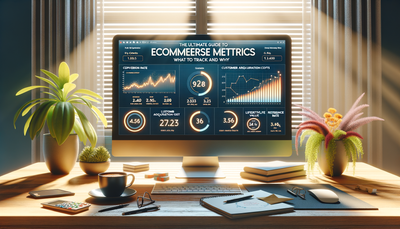Implementing a Virtual Tour on Your Business Website
In today's digital age, businesses are constantly seeking innovative ways to engage potential customers and showcase their offerings. One powerful tool that has gained significant traction is the virtual tour. By implementing a virtual tour on your business website, you can provide an immersive experience that allows visitors to explore your space from the comfort of their own devices. This article delves into the benefits of virtual tours, various methods for creating them, and how they can enhance your online presence. From 360-degree photography to interactive video tours, we'll explore the different options available and discuss how they can be tailored to suit your specific business needs.Table of Contents:

The Power of Virtual Tours
Virtual tours have become an invaluable asset for businesses across various industries. They offer a unique way to showcase your physical space, products, or services, providing potential customers with an interactive and engaging experience. By allowing visitors to explore your business virtually, you create a sense of familiarity and trust before they even step foot in your establishment.This immersive technology can be particularly beneficial for businesses in industries such as real estate, hospitality, education, and retail. Virtual tours can help potential buyers visualize properties, guests can preview hotel rooms or event spaces, students can explore campuses, and shoppers can get a feel for store layouts and product displays. The versatility of virtual tours makes them a powerful marketing tool for businesses of all sizes.
Do you need a website? Want to build a website but don't know where to start? Our website builder is the perfect solution. Easy to use, and with the ability to customize to fit your business needs, you can have a professional website in no time.
Benefits of Implementing a Virtual Tour
Adding a virtual tour to your business website offers numerous advantages. Firstly, it significantly enhances user engagement, keeping visitors on your site longer and increasing the likelihood of conversion. Virtual tours provide a more interactive and memorable experience compared to static images or text descriptions.Secondly, virtual tours can save time and resources for both your business and potential customers. By allowing people to explore your space remotely, you can reduce the number of in-person visits required, streamlining the decision-making process. This is particularly valuable for businesses with limited operating hours or those catering to long-distance clients.
Furthermore, virtual tours can set you apart from competitors, showcasing your commitment to innovation and customer experience. They also improve your website's SEO by increasing time spent on site and potentially lowering bounce rates. Lastly, virtual tours provide valuable data and insights into visitor behavior, helping you refine your marketing strategies and improve your offerings.
360-Degree Photography: Immersive Exploration
One of the most popular methods for creating virtual tours is through 360-degree photography. This technique involves capturing a series of high-resolution images that are stitched together to create a panoramic view of your space. Visitors can then navigate through these images, panning and zooming to explore different areas in detail.To create a 360-degree virtual tour, you'll need specialized equipment such as a 360-degree camera or a DSLR camera with a wide-angle lens and panoramic head. Many businesses opt to hire professional photographers who specialize in this type of photography to ensure high-quality results. Once the images are captured and processed, they can be integrated into your website using various virtual tour software platforms or custom-built solutions.
360-degree photography is particularly effective for showcasing interiors, exteriors, and landscapes. It allows visitors to get a comprehensive view of your space, creating a sense of presence and helping them make informed decisions.
Building a website with SITE123 is easy
Video Tours: Guided Experiences
Another effective method for implementing virtual tours is through video. Video tours offer a more guided experience, allowing you to showcase your space while providing narration or context. This format is particularly useful for businesses that want to highlight specific features or tell a story about their offerings.There are several approaches to creating video tours. You can opt for a traditional walkthrough video, where a camera operator moves through the space, capturing footage from various angles. Alternatively, you can create a more polished production with professional cinematography, editing, and voice-over narration.
To make video tours more interactive, consider incorporating clickable hotspots or overlays that provide additional information or allow viewers to jump to different sections of the tour. This adds an extra layer of engagement and allows visitors to explore areas of particular interest in more detail.
Interactive Elements: Enhancing Engagement
To take your virtual tour to the next level, consider incorporating interactive elements that allow visitors to engage with your space in unique ways. These elements can range from simple information pop-ups to more complex features like drag-and-drop functionality or customization options.For example, a furniture store could allow visitors to change the color or style of items within the virtual tour, helping them visualize different options. A hotel could incorporate clickable hotspots that provide information about amenities or allow guests to make reservations directly from the tour.
Interactive floor plans are another valuable addition, especially for businesses with large or complex spaces. These allow visitors to navigate between different areas easily and understand the layout of your establishment. By combining various interactive elements, you can create a truly immersive and informative experience that sets your virtual tour apart.
Implementing Virtual Tours on Your Website
Once you've created your virtual tour, the next step is to integrate it seamlessly into your website. There are several options for implementation, depending on your technical expertise and the complexity of your tour.For simple 360-degree photo tours, many website builders offer plugins or embeddable codes that allow you to easily add the tour to your site. These solutions often provide a user-friendly interface for uploading and customizing your tour.
For more complex tours with interactive elements or custom features, you may need to work with a web developer to ensure proper integration and functionality. This approach allows for greater customization and can help you create a unique experience tailored to your brand and business needs.
Regardless of the implementation method, it's crucial to ensure that your virtual tour is mobile-responsive and loads quickly across different devices. This will help maximize its effectiveness and reach the widest possible audience.





